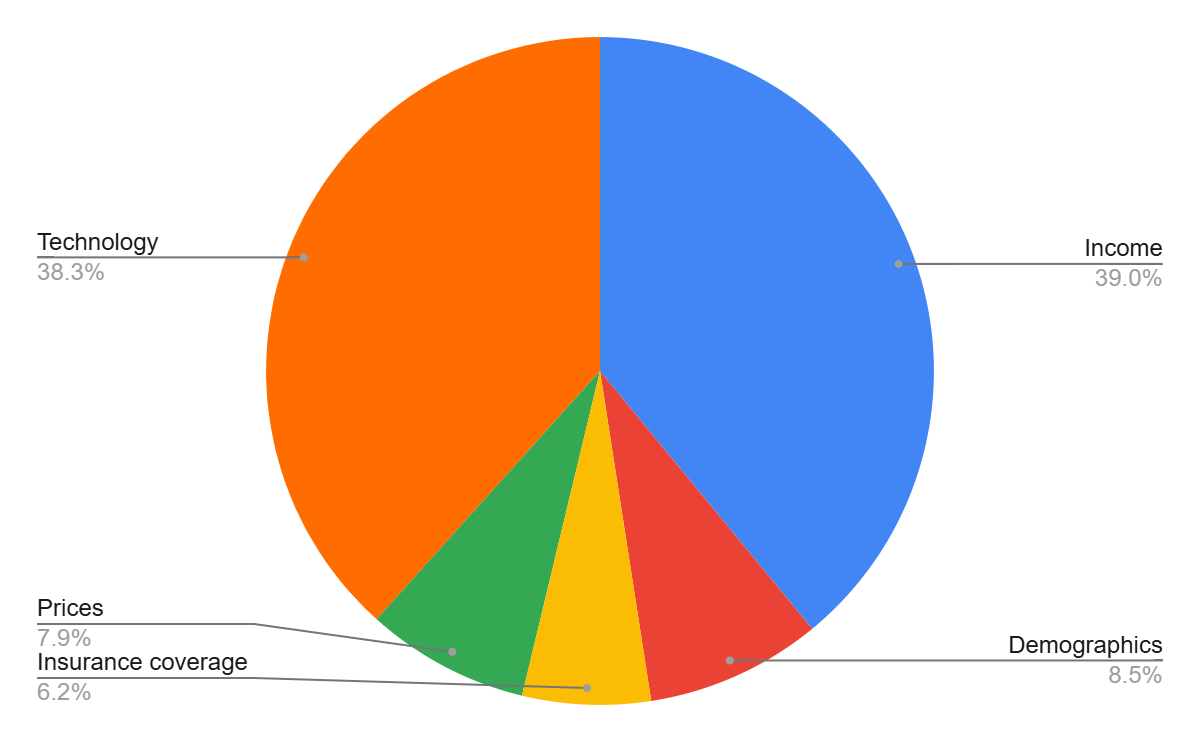Artificial Intelligence will Increase U.S. Health Spending
Health spending is driven by income and technology. AI will accelerate both.
Among folks who have asked the question, people seem to think AI will decrease health spending (even o3 agrees). Most cite Sahini 2023, which finds that AI could reduce health spending by 5% to 10%. Some potential mechanisms include automating away administrative costs, better fraud monitoring, using AI for healthcare instead of more expensive doctors and nurses, and improving health through remote monitoring or better health information or some other hopeful story.
Sahini 2023 is dressed up like an economics paper, but it’s really a McKinsey White Paper. Three of the four authors are management consultants, and its figures are actually screenshots of PowerPoint slides. It’s not really making a projection, as much as identifying business opportunities for potential clients.
To actually understand how AI might affect health spending, it’s good to start with fundamental drivers. Using a panel regression, estimated across 20 high-income countries over the last 50-years, Smith 2022 decomposes U.S. health spending growth across five factors: income, demographics, insurance coverage, relative prices, and technology. They find that almost 80% of U.S. health spending growth is attributable to changes in income and technology.
Share of Growth in Real per Capita Spending on Health Consumption Expenditures Attributed to Causal Factors, 1970–2019 (Source: Smith 2022, Table 2)
That’s pretty suggestive. If most health spending growth is driven by income and technology, and AI is going to accelerate income growth and technological change, then it would seem like AI is likely to increase (not decrease) U.S. health spending.
But this is actually one of those sneaky tricks, where the researchers label “unexplained variation” as “technology.” It potentially includes all sorts of things, including regulatory shocks and measurement error. Moreover, real technological effects are actually sprinkled elsewhere. Doesn’t technology affect income? Doesn’t technology affect prices? So technology isn’t really technology, and not-technology is largely technology.
Nonetheless, researchers really do think that technology tends to drive higher health spending, and this finding is supported by studies that do include proxy measures (e.g. R&D expenditure). For some reason, the kind of technology that people love making is the kind that you can patent and charge lots of money for. More confusingly, non-health technology can increase health spending through Baumol’s cost disease, which tends to drive price growth in less productive industries.
But how do we know those administrative/fraud/health/automation savings estimated in Sahini 2023 aren’t bigger than the income and technology effects? I did the math here. Taking their numbers at face value, their midpoint estimate was 7.5% in cost savings. But a lot of those savings will be captured by providers through higher margin, and to the extent providers just pocket the savings, AI is not actually reducing health spending. Adjusting for that, I estimate the Sahini findings imply about 3.3% in savings. Sticking with the evidence genre of “McKinsey ponders the opportunity,” in another report, they estimate that AI automation could boost U.S. productivity growth by between 1.0% and 3.8% per year. Applying OECD’s health spending elasticity to income (0.767) and multiplying by their midpoint GDP effect (2.4%), we get an extra annual health spending growth of about 1.8%.
Put differently, McKinsey’s own AI productivity effects imply that that their measured savings will be eaten up in about two years by AI-driven income gains. And this is before we account for the effects of a more expansive pipeline of expensive new treatments that AI cooks up or potential Baumol effects on prices. Those AI savings just aren’t that big when compared with what really drives healthcare spending.
If technology drives productivity improvements in other sectors, why can’t it do so in health care? I don’t know exactly why hospitals and doctors seem so immune to capitalism. Healthcare is one of the most regulated and most lobbied industries. The public has historically had high trust in doctors and hospitals, though less so post-COVID. The industry has been able to keep prices high using various policy tools, including licensure, certificate of need laws, and lax antitrust enforcement. Just like other technologies that, in theory, should save money (e.g. nurse practitioners, electronic health records), these regulatory obstacles will probably limit AI’s ability to drive savings.
Of course, it’s unclear how much AI flips the board and changes all of the rules. Baumol’s cost disease presumably presents differently once we reach 100% automation. But in this medium-term, still-somewhat familiar world, we should expect AI to make us richer and more technologically advanced. And that will lead to higher healthcare spending.




